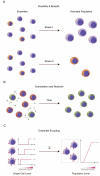Heterogeneity in immune responses: from populations to single cells
- PMID: 24746883
- PMCID: PMC4035247
- DOI: 10.1016/j.it.2014.03.004
Heterogeneity in immune responses: from populations to single cells
Abstract
The mammalian immune system is tasked with protecting the host against a broad range of threats. Understanding how immune populations leverage cellular diversity to achieve this breadth and flexibility, particularly during dynamic processes such as differentiation and antigenic response, is a core challenge that is well suited for single cell analysis. Recent years have witnessed transformative and intersecting advances in nanofabrication and genomics that enable deep profiling of individual cells, affording exciting opportunities to study heterogeneity in the immune response at an unprecedented scope. In light of these advances, here we review recent work exploring how immune populations generate and leverage cellular heterogeneity at multiple molecular and phenotypic levels. Additionally, we highlight opportunities for single cell technologies to shed light on the causes and consequences of heterogeneity in the immune system.
Keywords: cellular heterogeneity; immune response; phenotypic variation; single cell genomics.
Copyright © 2014 Elsevier Ltd. All rights reserved.
Figures





References
-
- Littman DR, Rudensky AY. Th17 and regulatory T cells in mediating and restraining inflammation. Cell. 2010 - PubMed
-
- Wing K, Sakaguchi S. Regulatory T cells exert checks and balances on self tolerance and autoimmunity. Nat Immunol. 2009 - PubMed
-
- Sakaguchi S, et al. regulatory T cells in the human immune system. Nature Publishing Group. 2010;10:490–500. - PubMed
Publication types
MeSH terms
Grants and funding
LinkOut - more resources
Full Text Sources
Other Literature Sources
Medical

